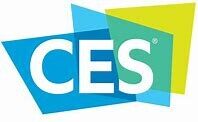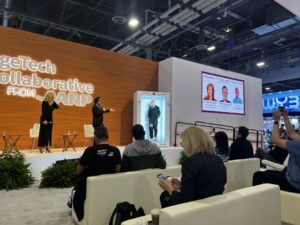Reflections on CES 2024
 In January, two SSR colleagues — Zac Hillyard, RSM, SmartScore AP, Principal, and Ryan Young, Technology Innovation Consultant — attended the annual Consumer Electronic Show (CES) in Las Vegas. The week-long event is the most powerful tech event in the world — the proving ground for breakthrough technologies and global innovators. The 2024 theme – All On – heavily focused on innovation in sustainability, inclusiveness, and AI. Read along as they discuss their experience at the conference, what they found most intriguing, and what excites them about the future of technology in healthcare.
In January, two SSR colleagues — Zac Hillyard, RSM, SmartScore AP, Principal, and Ryan Young, Technology Innovation Consultant — attended the annual Consumer Electronic Show (CES) in Las Vegas. The week-long event is the most powerful tech event in the world — the proving ground for breakthrough technologies and global innovators. The 2024 theme – All On – heavily focused on innovation in sustainability, inclusiveness, and AI. Read along as they discuss their experience at the conference, what they found most intriguing, and what excites them about the future of technology in healthcare.
Was this your first experience at the CES conference?
 Zac Hillyard: No, I’ve attended the past few years. Initially, I attended to research and explore innovative advancements redefining how technology consumers live and work better. This was my 4th consecutive year participating; every year there are more inspiring solutions and novel designs. It’s an innovation super bowl event I look forward to each year!
Zac Hillyard: No, I’ve attended the past few years. Initially, I attended to research and explore innovative advancements redefining how technology consumers live and work better. This was my 4th consecutive year participating; every year there are more inspiring solutions and novel designs. It’s an innovation super bowl event I look forward to each year!
 Ryan Young: Yes, and it was a genuinely wild experience! I felt like a kid in a candy store. I’ve attended many conferences but never one of the scale of CES. It was hosted in 5 or 6 different convention centers and consistently had 2 – 3 simultaneous events that I wanted to attend. Not to mention the number of booths on the floor I wanted to see, over 4500 vendors.
Ryan Young: Yes, and it was a genuinely wild experience! I felt like a kid in a candy store. I’ve attended many conferences but never one of the scale of CES. It was hosted in 5 or 6 different convention centers and consistently had 2 – 3 simultaneous events that I wanted to attend. Not to mention the number of booths on the floor I wanted to see, over 4500 vendors.
What was the neatest thing you saw at CES?
Zac: Generally seeking out technology health care products within the digital health segment of the show, I was inspired by several new innovative solutions that prompt transformative design concepts and unique operational use cases for health care facilities in the near future. A first of its kind transportable atmospheric freshwater generation system called the Genesis Water Cube. This automated and sustainable off-grid solution can create up to 5,000 gallons of water a day out of ambient air. Imagine the variety of applications for something like this in situations where conventional water supply distribution is simply not feasible — disaster relief — for populations that don’t have access to clean water. Innovations like this hold great potential for engineering facility resiliency or redundancy design goals.
I was also impressed with HL Mando’s Parkie, an unusual autonomous mobile robot (AMR) driving-based parking servant. One of the more challenging design goals for new healthcare facilities is to deliver elevated parking user experiences within a balanced constructability cost estimate of a substantial parking structure. Parkie reframes a parking structure design strategy through optimizing AI technology to better serve the automobile driver and the facility operator. Eliminating the need to open both driver and passenger doors, spatial requirements for a typical parking spot become tighter and return more efficient space design layouts. Coincidently, this ultimately reduces the physical bill of materials and associated expense of a traditional and less efficient parking structure. By effectively integrating this innovation within the patient arrival and exiting workflows, virtual valet amenities are very possible to delight customers and healthcare operational administrators alike. This emerging technology provides convenience to patients and visitors of the organization while also increasing the utilization of garages by up to 30%.
Ryan: There were too many things that stood out to talk about just one! I echo Zac about the Genesis Water Cube. It’s an incredible system that extracts fresh, drinkable water directly from the air using renewable energy sources. This could revolutionize other industries like healthcare too — imagine a water backup generator similar to how many facilities have power backup generators.
Abbott’s new FDA-approved, rapid i-STAT TBI test analyzes blood biomarkers for quick and accurate diagnosis of concussions. This innovation has the potential to revolutionize concussion assessment in sports like the NFL, replacing subjective protocols with objective, data-driven medical decisions.
Hyundai unveiled futuristic, electric construction equipment designed for remote control operation. This concept transitions construction towards centralized control centers resembling drone operations, promoting improved safety, labor flexibility, precision, and potential cost savings.
Technology is evolving when it comes to your city and the services they provide. Imagine a robot street cleaner or even a robotic garbage truck, without the need for any people to operate it. Lotus Robotics showcased autonomous driving software and several hardware robots including its ROBOCube, an intelligent street cleaner.
What excited you about the future of technology in healthcare?
Zac: As common amongst every industry market showcased at CES, a heavy focus on ‘AI’ in the healthcare setting was centerstage. Becoming widely marketed, ‘AI’ is commonly perceived as ‘artificial intelligence’. It was interesting to observe how leading technology giants have rescripted the ‘AI’ to embody new consumer faculties and services.
Hearing LG redefine AI as ‘Affectionate Intelligence” demonstrating their mission of providing tangible real-world benefits through AI to foster user experiences that are more caring, empathetic, and attentive. This reshapes the depth and spatial implications that healthcare designers and solution providers will leverage ‘AI’ to offset traditional space plans. Framing this new intelligence as artificial, ambient, or affectionate, it’s really exciting for the versatile addition of ‘AI’ into the designer’s tool chest to empower smart building technologies, diverse autonomous workflows, and empathetic use case outcomes. Seeing ‘AI’ become the mortar to truly optimize the brick and block layers of future facilities, I am excited to continue our diagnostic collaboration with technology partners, architectural design firms, and healthcare facility owners to unify the seamless demands of the future physical and digital built environments.
Ryan: Wearable fitness and health trackers. There were dozens of these products at CES, so I’ll be general. The rapid advancement of bio wearables is incredibly exciting. We’re seeing devices that go beyond basic fitness tracking, now providing continuous, real-time monitoring of critical health metrics like blood glucose levels, blood pressure, temperature, lactate, ketones, hydration, and now much improved heart rate tracking. The important thing here is that these are becoming more reliable, which means the data they provide will be much more useful to not only us, but to our doctors as well.
Imagine this scenario: your doctor prescribes a new medication. Instead of waiting weeks for a follow-up visit to check its effectiveness, your wearable device immediately starts tracking your body’s responses. An app logs when you take your medication, while the wearable monitors your critical biomarkers. This real-time data gives your doctor immediate insight into how the medication is affecting you, allowing them to quickly fine-tune your treatment plan for optimal results.
This shift has the power to change our future interactions with healthcare providers. Instead of relying on single data points, like a blood test from your once-a-year checkup, these wearables will provide continuous, real-time health insights. This will give doctors the data to shift from reactive to proactive care, optimizing treatments and interventions based on how your body responds in real-time. This change could take some time to occur, as it’s going to shake up the traditional doctor patient model. I think we will see an entirely new business model emerge from doctors willing to adapt, marketing this service line of consistent monitoring and proactive care.
This also enables a future where these wearables integrate with healthcare systems, alerting providers to potential issues before they become critical events.
Did you see anything you want to integrate into a project you are currently working on?
Zac: Throughout the digital health conference series, I heard a lot about the Quintuple Aim, a five-prong approach to lead healthcare improvement and for success in value-based care. It’s an extension of the 2014 Quadruple Aim, with a new emphasis on the importance of optimizing the overall healthcare system to establish health equity. The viability of health equity is correlated with evolutions in widely accessible and impactful consumer technologies.
Withings Health Solutions had several products that speak to health equity goals. A personal all-in-one clinical synergy device, the Beam-o solution combines a digital stethoscope, mini oximeter, electrocardiogram, and contactless thermometer. Adopting new organizational strategies for empowering patients (a.k.a. ‘consumers’) through widely available, affordable, and accessible lifestyle sensor monitoring technologies galvanizes the reengineered focus toward health equity goals. Their ability to provide remote patient monitoring and at home diagnostics could greatly impact health equity, allowing the patient to stay at home while autonomously communicating vitals to their equipped and preferred healthcare organization.
 Ryan: Proto Hologram, showcased at the massive AARP booth, attracted a big crowd during their presentation with a William Shatner hologram and later a live feed of Howie Mandel. Proto Hologram is an innovative technology that creates lifelike, three-dimensional projections, allowing for much more immersive interactions without physical presence versus a standard TV monitor. There are rumors about an upcoming model that promises a significantly smaller footprint, making it even more versatile and suitable for various environments, from healthcare facilities to educational institutions.
Ryan: Proto Hologram, showcased at the massive AARP booth, attracted a big crowd during their presentation with a William Shatner hologram and later a live feed of Howie Mandel. Proto Hologram is an innovative technology that creates lifelike, three-dimensional projections, allowing for much more immersive interactions without physical presence versus a standard TV monitor. There are rumors about an upcoming model that promises a significantly smaller footprint, making it even more versatile and suitable for various environments, from healthcare facilities to educational institutions.
Proto Hologram technology could be implemented in healthcare facilities by allowing specialists to provide care remotely, appearing as holograms for consultations, education, and patient monitoring. It can be used in patient rooms, training areas, and even waiting rooms to enhance learning and patient care. This would enable patients to consult with healthcare specialists from anywhere in the world without the need for travel, particularly beneficial for those who are ill.
This technology can revolutionize educational spaces too by making learning more immersive in science labs, history classes, and art studios, turning lessons into vivid experiences. It can enhance libraries and study areas with interactive modules and virtual lectures and enable teachers to “beam” into classrooms from anywhere, breaking down geographical barriers while maintaining a personal connection with students.
Zac and I had the chance to interact with the Proto Hologram technology during a visit with Dr. Bari Hoffman at the Innovation Hub at the University of Central Florida. Dr. Hoffman showed us the ropes of the Proto Hologram technology, top to bottom. She has one room dedicated to recording and capturing live images and explained how the setup can be as simple as a single iPhone to record or a more advanced setup with high-resolution cameras. It was impressive to see live feeds turn into holograms right before our eyes. Zac even stepped into the capture area and appeared as a hologram on the other end instantly. Dr. Hoffman also shared recordings of her students getting hands-on with the tech and some interesting use cases like patient education and testimonials in hologram form. It was an amazing peek into what the future of communication and learning could look like.
Zac: It’s this exposure, comprehension, and collaboration to these upcoming (and in some cases, available) technologies that makes our attendance at CES so important. Averaging 18k steps a day, it’s an incredibly busy and exhausting week. However, solution application, benefits, and use cases have incredible value for our team and our clients. Many owners are in attendance and have recognized these digital health consumer trends, especially from the larger healthcare systems, and it’s really rewarding to collaborate with them during the conference about what we’re seeing and how innovative solutions could be implemented to serve the future of healthcare.







